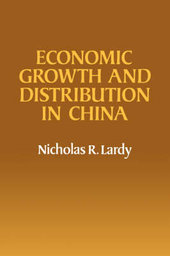
|
Economic Growth and Distribution in China
Hardback
Main Details
| Title |
Economic Growth and Distribution in China
|
| Authors and Contributors |
By (author) Nicholas R. Lardy
|
| Physical Properties |
| Format:Hardback | | Pages:260 | | Dimensions(mm): Height 234,Width 152 |
|
| Category/Genre | Economic theory and philosophy |
|---|
| ISBN/Barcode |
9780521219044
|
| Classifications | Dewey:330.95105 330.9/51/05 |
|---|
| Audience | | Professional & Vocational | |
|---|
|
Publishing Details |
| Publisher |
Cambridge University Press
|
| Imprint |
Cambridge University Press
|
| Publication Date |
31 August 1978 |
| Publication Country |
United Kingdom
|
Description
This study maintains that China's system of economic planning tends to mitigate the trade-off between economic growth and equity that has been found to prevail in the early stages of development in most less developed countries. The analysis focuses on the Chinese leadership's attempt to improve economic efficiency by decentralizing economic management without encouraging, as a consequence, increased economic inequality among different regions. By examining the budgetary and planning process, focusing in particular on the fiscal relations between the centre and the far-reaching degree of resource redistribution undertaken by the central government through its control of interprovincial and intersectoral resource transfers. Professor Lardy's analysis highlights the essential features of Chinese economic growth and relates these to the experience of both developing and Soviet-type economies. The study begins by exploring the implications of alternative systems of resource allocation in an economy marked by an unusually high degree of inequality in per capita output both across different regions as well as in different sectors. The adoption of a highly centralized system of economic planning in the early 1950s is shown to have stemmed not only from the influence of the Soviet model, but also from a desire to use relatively centralized economic policy instruments to accelerate the growth of less developed regions.
|